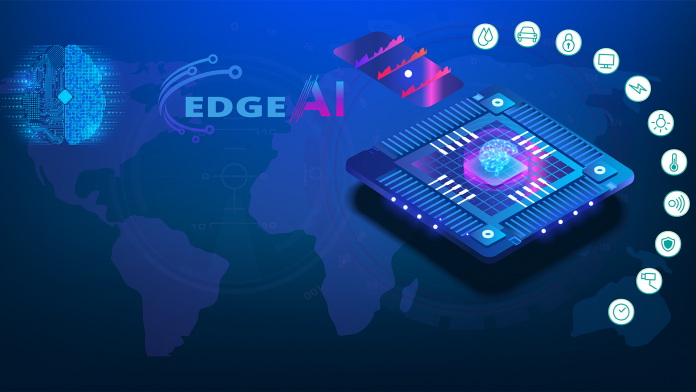
Edge AI is transforming how artificial intelligence is deployed and utilized by bringing data processing closer to the source. Traditionally, AI models have relied on cloud computing to process large amounts of data, often requiring significant time and bandwidth to send data to remote servers for analysis. With edge AI, however, data is processed directly on devices at the edge of the network, such as smartphones, IoT devices, and sensors. This shift is revolutionizing industries by enabling faster decision-making, reducing latency, and minimizing the need for extensive cloud infrastructure. In this article, we will explore what Edge AI is, its applications, and the benefits it offers to various industries.
What is Edge AI?
Edge AI refers to the integration of artificial intelligence algorithms directly into hardware devices at the edge of a network, rather than relying solely on cloud-based servers for data processing. By processing data locally, edge AI enables devices to make decisions without the need to send large amounts of data back and forth to remote servers. This allows for faster, more efficient processing and real-time responses to data inputs. Edge AI is typically used in conjunction with Internet of Things (IoT) devices, autonomous vehicles, and smart devices iowa headlines.com, which generate vast amounts of data that need to be processed quickly and accurately.
The Importance of Edge AI in Reducing Latency
One of the primary advantages of edge AI is its ability to reduce latency. Traditional cloud-based AI systems often suffer from delays because data must travel to a central server for processing before a decision is made and the results are sent back to the user. With edge AI, data is processed locally on the device, which dramatically reduces the time it takes to analyze and respond to the data. This is especially critical in applications where real-time decisions are essential, such as in autonomous vehicles, industrial automation, and healthcare monitoring. By processing data on the edge, edge AI enables immediate action and faster response times.
Edge AI and Data Privacy
Data privacy is a growing concern in today’s digital world, particularly when it comes to personal and sensitive information. Edge AI offers a significant advantage in this area, as it enables data to be processed locally rather than being transmitted to remote servers. This reduces the risk of data breaches and unauthorized access, as the data does not need to leave the device. For industries such as healthcare, finance, and security, where sensitive data is involved, edge AI provides a more secure solution by ensuring that data is kept within trusted environments. Additionally, by minimizing the need for data transmission, edge AI can help comply with privacy regulations, such as GDPR, that govern the handling of personal data.
Edge AI and IoT: A Perfect Partnership
The integration of edge AI with the Internet of Things (IoT) is creating a powerful synergy. IoT devices, such as smart thermostats, wearable health monitors, and industrial sensors, generate massive amounts of data that need to be processed quickly to provide useful insights. Edge AI enables these devices to analyze data locally, making real-time decisions without relying on cloud computing. For example, a smart thermostat with edge AI can analyze temperature data and adjust settings immediately, without waiting for cloud-based processing. This not only reduces latency but also improves the efficiency and functionality of IoT devices, allowing them to operate autonomously and intelligently.
The Role of Edge AI in Autonomous Systems
Edge AI plays a critical role in autonomous systems, such as self-driving cars and drones. These systems require real-time processing of data from sensors and cameras to make immediate decisions. Cloud-based AI systems, while powerful, can introduce delays due to the need to transmit data to and from remote servers. Edge AI addresses this challenge by processing data locally, enabling autonomous systems to make faster, more accurate decisions in real-time. For example, an autonomous vehicle equipped with edge AI can quickly process data from its sensors to avoid obstacles and navigate traffic, without waiting for cloud-based analysis. This reduces the risk of accidents and improves the overall safety of autonomous systems.
Cost-Effectiveness of Edge AI
Another key advantage of edge AI is its cost-effectiveness. Cloud-based AI models often require substantial infrastructure, including powerful servers and large-scale data storage, which can be expensive to maintain. With edge AI, much of the processing is done locally on devices, reducing the need for extensive cloud infrastructure. This can result in lower operational costs, particularly for industries that rely on a large number of devices, such as manufacturing, logistics, and agriculture. Additionally, by processing data on the edge, businesses can minimize the bandwidth required for data transmission, reducing data transfer costs and optimizing network usage.
Edge AI in Healthcare
Edge AI is making a significant impact in the healthcare industry by enabling real-time monitoring and decision-making. Wearable devices and remote patient monitoring systems equipped with edge AI can analyze health data locally, providing immediate insights into a patient’s condition. For example, an edge AI-enabled wearable device can monitor a patient’s heart rate and alert them or their healthcare provider if there are signs of abnormal activity, all in real time. This type of local processing ensures faster responses and better patient outcomes. Additionally, by reducing the need to transmit large amounts of sensitive health data to the cloud, edge AI helps address privacy concerns while improving the efficiency of healthcare systems.
The Future of Edge AI
The future of edge AI is bright, with continued advancements in both AI technology and hardware capabilities. As more devices become connected and capable of processing data locally, the applications of edge AI will expand across various industries. In the coming years, we can expect edge AI to play an even greater role in sectors such as healthcare, autonomous vehicles, manufacturing, and logistics. With the advent of 5G networks, which provide faster data transfer speeds and greater bandwidth, edge AI will become even more powerful, enabling devices to process and analyze data more efficiently than ever before. As the technology matures, edge AI is expected to become an integral part of the digital landscape.
Challenges of Edge AI Adoption
While edge AI offers numerous benefits, there are also challenges to its widespread adoption. One of the primary challenges is the limited computational power of edge devices compared to centralized cloud servers. This means that certain AI models, particularly those requiring complex processing or large datasets, may not be suitable for edge devices. Additionally, the deployment of edge AI requires robust security measures to protect data and prevent unauthorized access. Ensuring that devices are secure and that data privacy is maintained will be essential for the continued growth of edge AI. Furthermore, the need for ongoing updates and maintenance of AI models on edge devices can present logistical challenges for businesses.
Conclusion: The Impact of Edge AI on the Digital Transformation
Edge AI is playing a pivotal role in the digital transformation of industries worldwide. By processing data locally, edge AI reduces latency, improves data privacy, and enhances the functionality of devices. From autonomous vehicles to healthcare and IoT, the applications of edge AI are diverse and far-reaching. As technology continues to evolve, edge AI will become increasingly critical in enabling real-time decision-making and unlocking new efficiencies across industries. While challenges remain, the potential of edge AI to revolutionize data processing and enhance user experiences is undeniable. As we move into a more connected future, edge AI will undoubtedly shape the way we interact with technology.









Leave a Reply